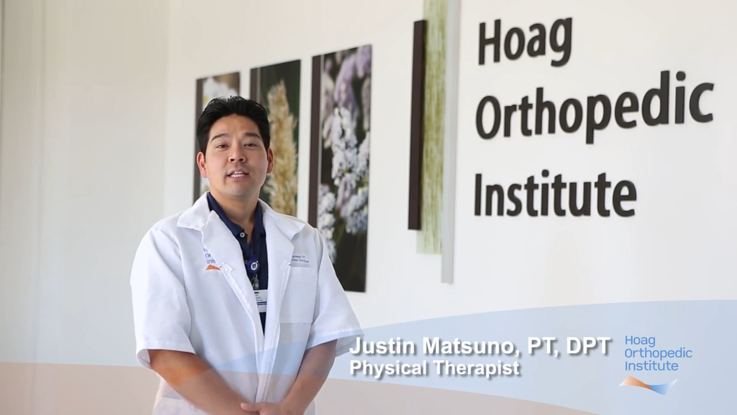Spondylolisthesis
Treating Lower Back Pain in Orange County
Spondylolisthesis is a condition that occurs when an anterior vertebra slips out of position in the spinal column and slides over the bone below. It most often occurs in the lumbar or sacral region of the spine (lower back), and can cause pain from the spinal cord or nerve roots being compressed. The most common symptoms are lower back pain and/or leg pain that limits activity level such as having difficulty walking, weakness, and numbness in the lower back and pain that may radiate down the buttock and into the leg (sciatica). In severe cases, it can cause loss of bladder or bowel control.
Spondylolisthesis can stem from various problems affecting the back, including defects and injuries. For example, it may be caused by congenital conditions affecting joints, infections, or arthritis. It may also be caused by accidents, trauma, and overuse that leads to stress fractures or herniated discs.
Spondylolysis is a condition relatively common in children and young adults (typically 10 to 15 year olds) who participate in sports where there is repetitive stress on the lower back, such as football, weightlifting, and gymnastics. It typically results from stress fractures or cracks that occur in one of the spinal column’s vertebrae. There is a chance if the affected area doesn’t heal correctly, that the continued stress can lead to the slippage of spondylolisthesis and recurrent low back pain.
Treating Spondylolisthesis
Spondylolisthesis may or may not cause noticeable symptoms. However, more severe slippage (high grade) can cause significant pain that affects a person’s ability to handle daily tasks and participate in sports or activities they enjoy. In cases where patients experience pain, personalized assessments and diagnostic testing are essential to identifying the underlying cause and treatment plan. These plans may begin with non-surgical care, such as rest, bracing to immobilize the spine, physical therapy, and pain management (such as epidural steroid injections).
Should non-surgical treatment fail to relieve pain or improve motion, or when slippage is severe, surgery may be required. Surgery will often include a decompressive laminectomy to reduce irritation and inflammation in the nerve roots or spinal cord area or spinal fusion, which joins vertebrae in the spine and provides stabilization of the affected area. Rest, bracing, rehabilitation, and specific exercises to strengthen the back and abdominal muscles will help patients as they recover following surgery.
Most patients are able to make a full recovery following treatment for spondylolisthesis, and will often be pain free and able to return to sports and other activities gradually over time.
Find a Spine Doctor in Orange County
Helping patients improve motion, resolve pain, and return to an active and healthy life is always our top objective at the Center for Spine at Hoag Orthopedic Institute. Backed by board-certified, fellowship-trained specialists who take a multi-disciplinary approach to treating patients, we ensure that you have the information and support needed to address your underlying condition, navigate treatment or surgery, and make the most of your recovery.
Find a
spine doctor today by browsing our online
physician directory.
-
 Back to Driving Spine
Back to Driving Spine"Procedure: Complex Spinal Surgery Watching TV, taking long walks, getting up out of a ..."
Read More -
 Back to Enjoying Life Spine
Back to Enjoying Life Spine"Procedure: Spinal fusion Jonathan Dibiasi and his family love spending time at their ..."
Read More -
 Back to Running Spine, Sports Medicine
Back to Running Spine, Sports Medicine"“I can’t believe I’m walking, let alone running,” says car crash survivor, seven-time ..."
Read More -
 Back to Savoring Every Day Hand & Wrist, Spine
Back to Savoring Every Day Hand & Wrist, Spine"Procedures: Spinal Surgery: January 16, 2017; Right Wrist Fusion: January 12, 2018 ..."
Read More -
 Back to Painting Spine
Back to Painting Spine"Procedure : Multi-level Spinal Fusion At age 69, lifelong professional artist ..."
Read More -
 Back to Wearing Cowboy Boots Spine
Back to Wearing Cowboy Boots Spine"For two years, Sally Greer spent most of her time on her couch, and gained 130 pounds ..."
Read More -
 Back to Being Healthy Spine
Back to Being Healthy Spine"I would like to get a message to a couple of your staff members and their supervisor. ..."
Read More -
 Back to Dancing Spine
Back to Dancing Spine"For the past decade, Irvine aerospace engineer Shoja’s zest for life led him to grace ..."
Read More -
 Back to a Better Life Spine
Back to a Better Life Spine"I had spine surgery by Dr. Richard Lee on January 3rd. It appears to have been been ..."
Read More










